University Finance for Business - Masters Assignment Solutions
VerifiedAdded on 2023/06/10
|19
|2131
|98
Homework Assignment
AI Summary
This document presents a comprehensive solution to a Masters-level finance assignment, covering a wide array of financial concepts and calculations. The assignment addresses key areas such as bond valuation, break-even analysis, capital budgeting, cost of equity, and dividend valuation models. It includes detailed calculations for Net Present Value (NPV), Internal Rate of Return (IRR), Weighted Average Cost of Capital (WACC), and portfolio analysis. The solution explores debt ratios, beta coefficients, and the application of the Security Market Line (SML). Furthermore, it delves into topics like payback period, profitability index, and the impact of dividend policies on stock valuation. The document provides step-by-step solutions to various financial problems, offering insights into investment decisions and financial performance analysis. This assignment provides a strong foundation in financial management and investment analysis.
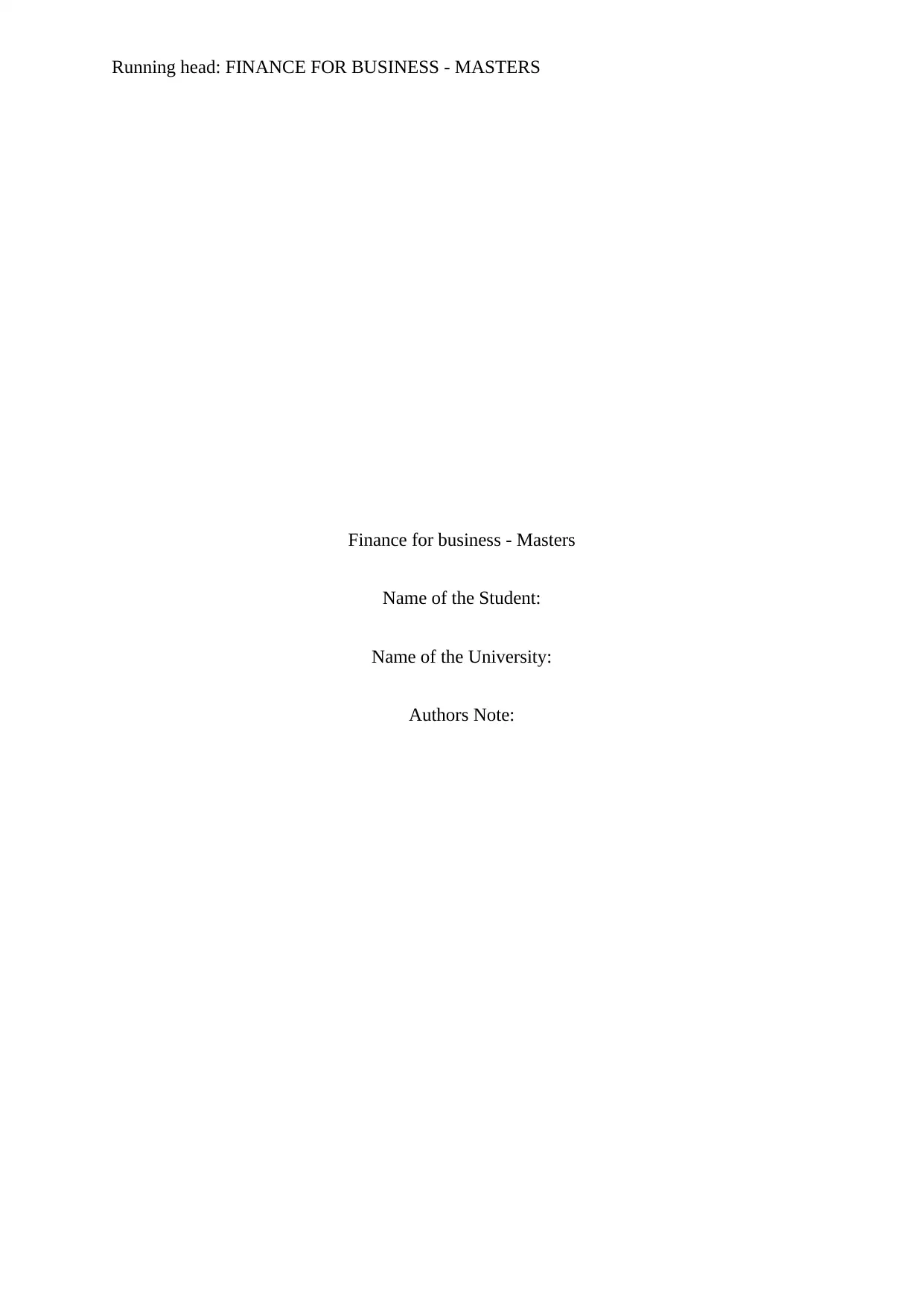
Running head: FINANCE FOR BUSINESS - MASTERS
Finance for business - Masters
Name of the Student:
Name of the University:
Authors Note:
Finance for business - Masters
Name of the Student:
Name of the University:
Authors Note:
Paraphrase This Document
Need a fresh take? Get an instant paraphrase of this document with our AI Paraphraser
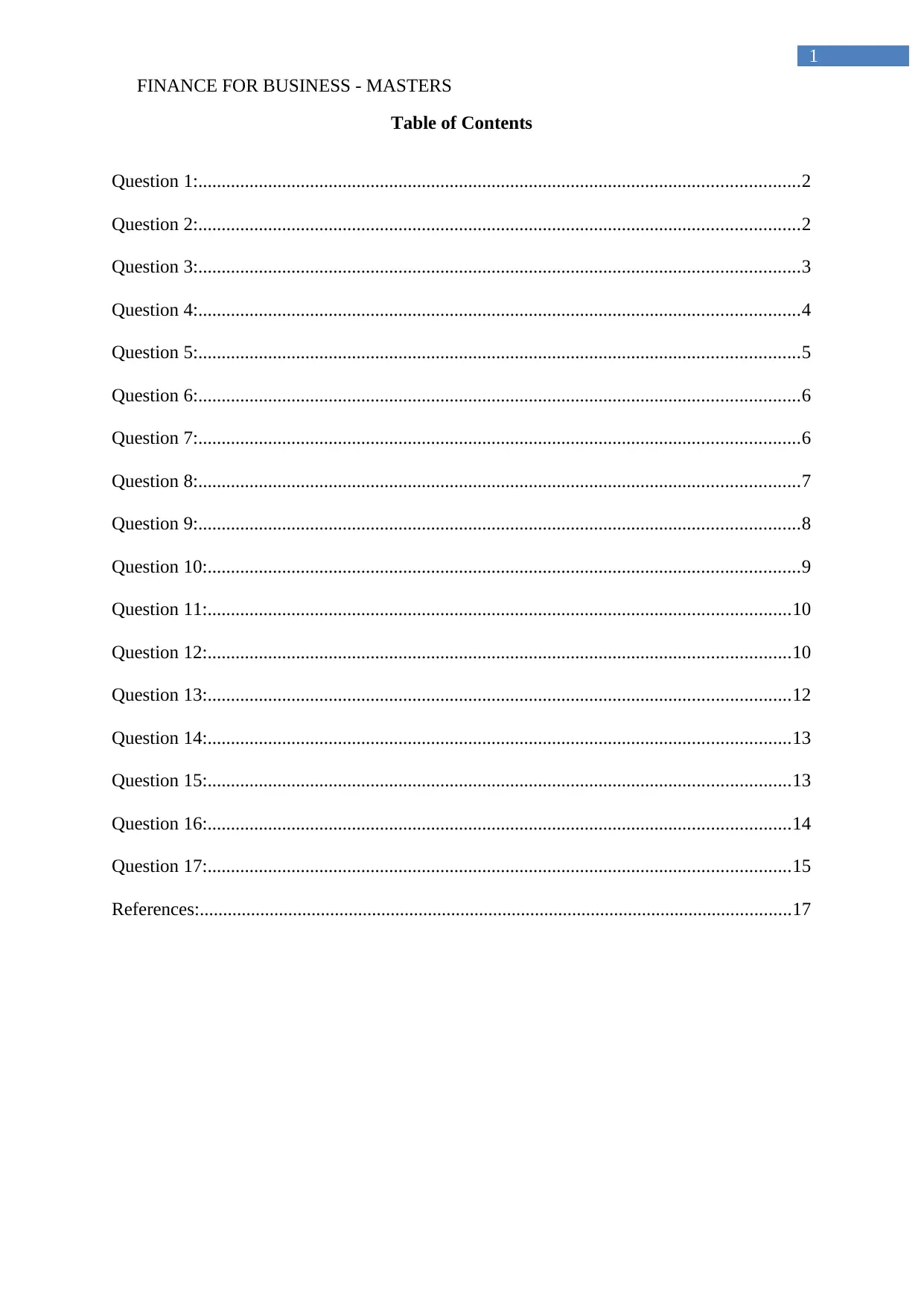
FINANCE FOR BUSINESS - MASTERS
1
Table of Contents
Question 1:.................................................................................................................................2
Question 2:.................................................................................................................................2
Question 3:.................................................................................................................................3
Question 4:.................................................................................................................................4
Question 5:.................................................................................................................................5
Question 6:.................................................................................................................................6
Question 7:.................................................................................................................................6
Question 8:.................................................................................................................................7
Question 9:.................................................................................................................................8
Question 10:...............................................................................................................................9
Question 11:.............................................................................................................................10
Question 12:.............................................................................................................................10
Question 13:.............................................................................................................................12
Question 14:.............................................................................................................................13
Question 15:.............................................................................................................................13
Question 16:.............................................................................................................................14
Question 17:.............................................................................................................................15
References:...............................................................................................................................17
1
Table of Contents
Question 1:.................................................................................................................................2
Question 2:.................................................................................................................................2
Question 3:.................................................................................................................................3
Question 4:.................................................................................................................................4
Question 5:.................................................................................................................................5
Question 6:.................................................................................................................................6
Question 7:.................................................................................................................................6
Question 8:.................................................................................................................................7
Question 9:.................................................................................................................................8
Question 10:...............................................................................................................................9
Question 11:.............................................................................................................................10
Question 12:.............................................................................................................................10
Question 13:.............................................................................................................................12
Question 14:.............................................................................................................................13
Question 15:.............................................................................................................................13
Question 16:.............................................................................................................................14
Question 17:.............................................................................................................................15
References:...............................................................................................................................17
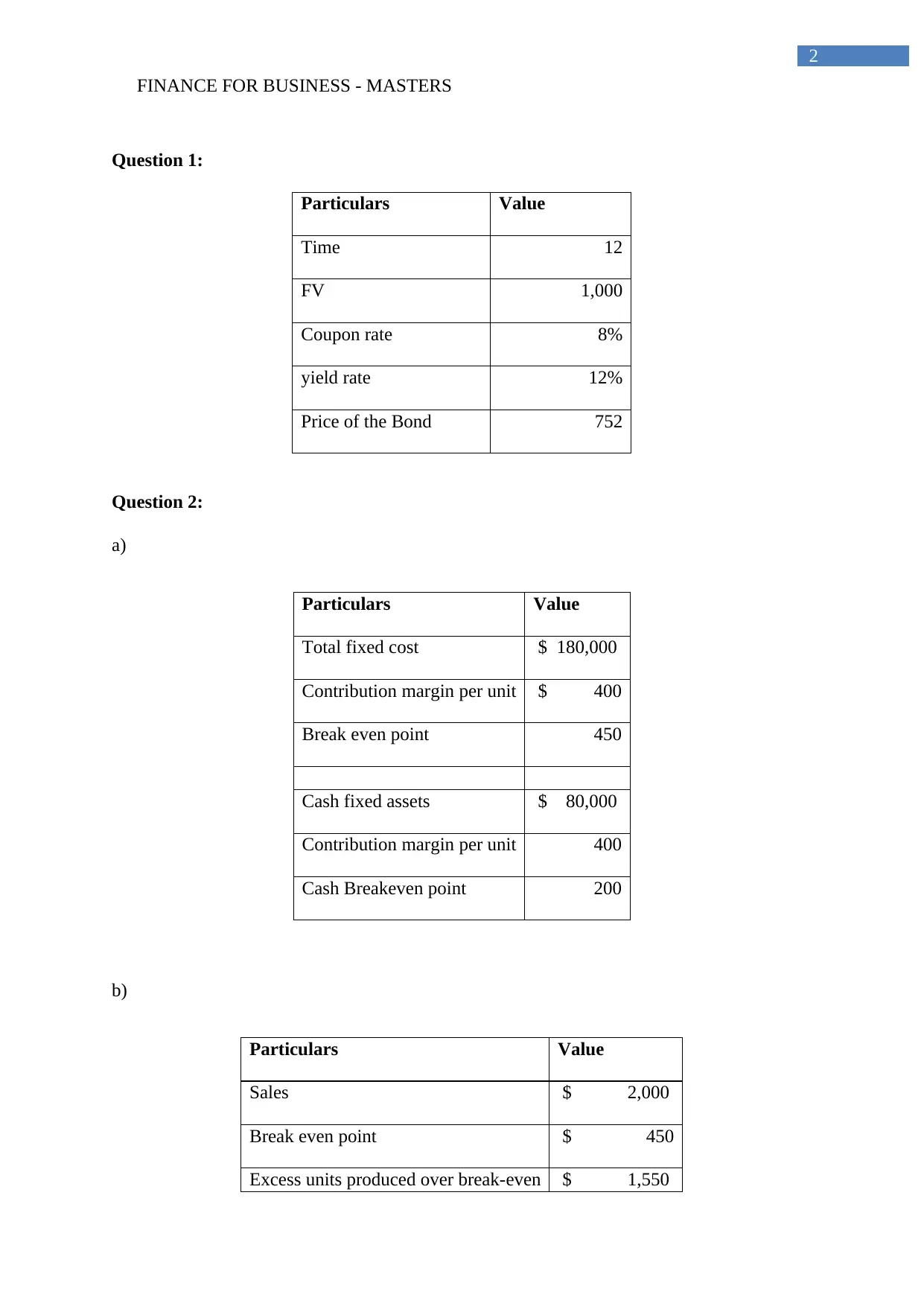
FINANCE FOR BUSINESS - MASTERS
2
Question 1:
Particulars Value
Time 12
FV 1,000
Coupon rate 8%
yield rate 12%
Price of the Bond 752
Question 2:
a)
Particulars Value
Total fixed cost $ 180,000
Contribution margin per unit $ 400
Break even point 450
Cash fixed assets $ 80,000
Contribution margin per unit 400
Cash Breakeven point 200
b)
Particulars Value
Sales $ 2,000
Break even point $ 450
Excess units produced over break-even $ 1,550
2
Question 1:
Particulars Value
Time 12
FV 1,000
Coupon rate 8%
yield rate 12%
Price of the Bond 752
Question 2:
a)
Particulars Value
Total fixed cost $ 180,000
Contribution margin per unit $ 400
Break even point 450
Cash fixed assets $ 80,000
Contribution margin per unit 400
Cash Breakeven point 200
b)
Particulars Value
Sales $ 2,000
Break even point $ 450
Excess units produced over break-even $ 1,550
⊘ This is a preview!⊘
Do you want full access?
Subscribe today to unlock all pages.

Trusted by 1+ million students worldwide
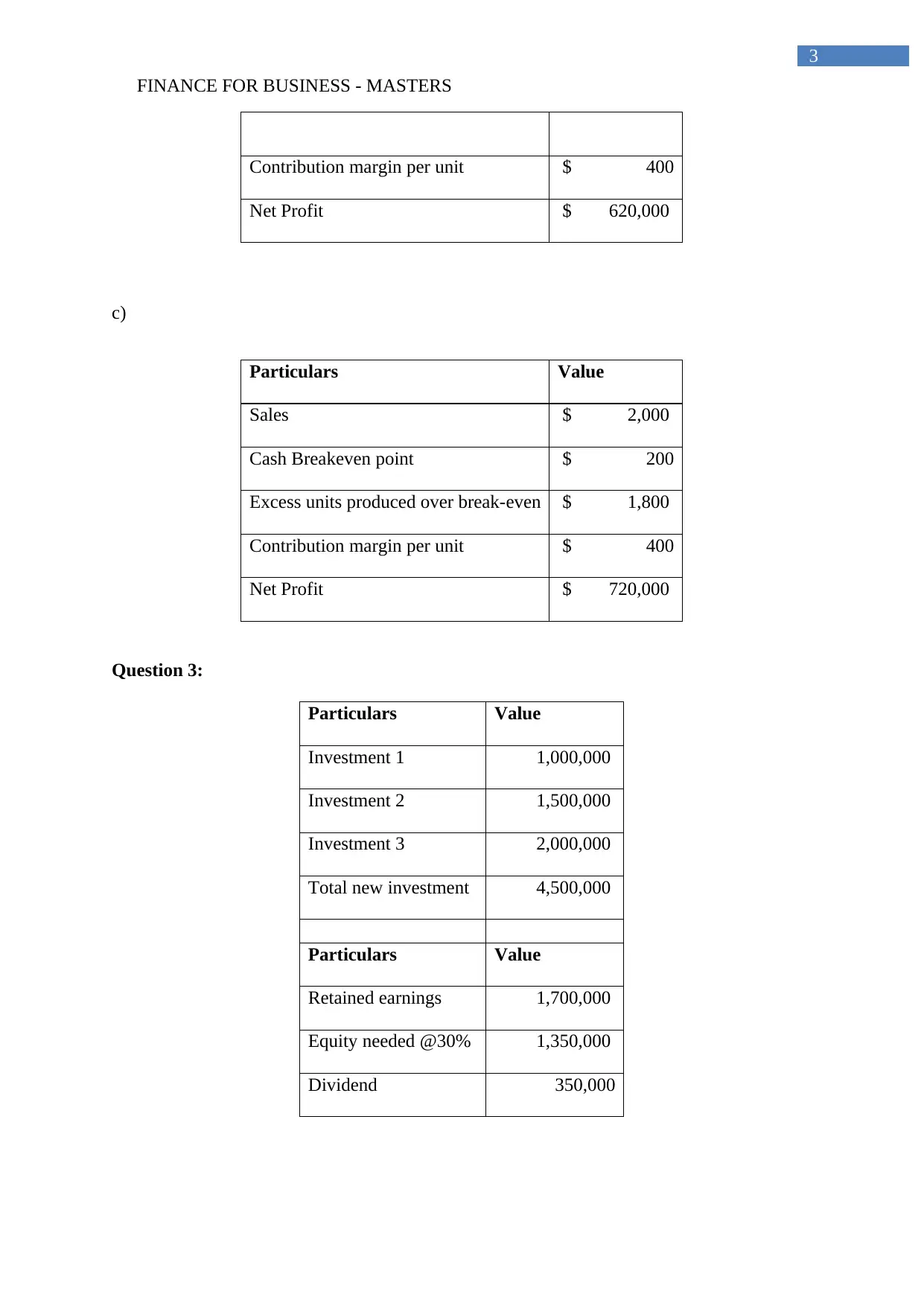
FINANCE FOR BUSINESS - MASTERS
3
Contribution margin per unit $ 400
Net Profit $ 620,000
c)
Particulars Value
Sales $ 2,000
Cash Breakeven point $ 200
Excess units produced over break-even $ 1,800
Contribution margin per unit $ 400
Net Profit $ 720,000
Question 3:
Particulars Value
Investment 1 1,000,000
Investment 2 1,500,000
Investment 3 2,000,000
Total new investment 4,500,000
Particulars Value
Retained earnings 1,700,000
Equity needed @30% 1,350,000
Dividend 350,000
3
Contribution margin per unit $ 400
Net Profit $ 620,000
c)
Particulars Value
Sales $ 2,000
Cash Breakeven point $ 200
Excess units produced over break-even $ 1,800
Contribution margin per unit $ 400
Net Profit $ 720,000
Question 3:
Particulars Value
Investment 1 1,000,000
Investment 2 1,500,000
Investment 3 2,000,000
Total new investment 4,500,000
Particulars Value
Retained earnings 1,700,000
Equity needed @30% 1,350,000
Dividend 350,000
Paraphrase This Document
Need a fresh take? Get an instant paraphrase of this document with our AI Paraphraser
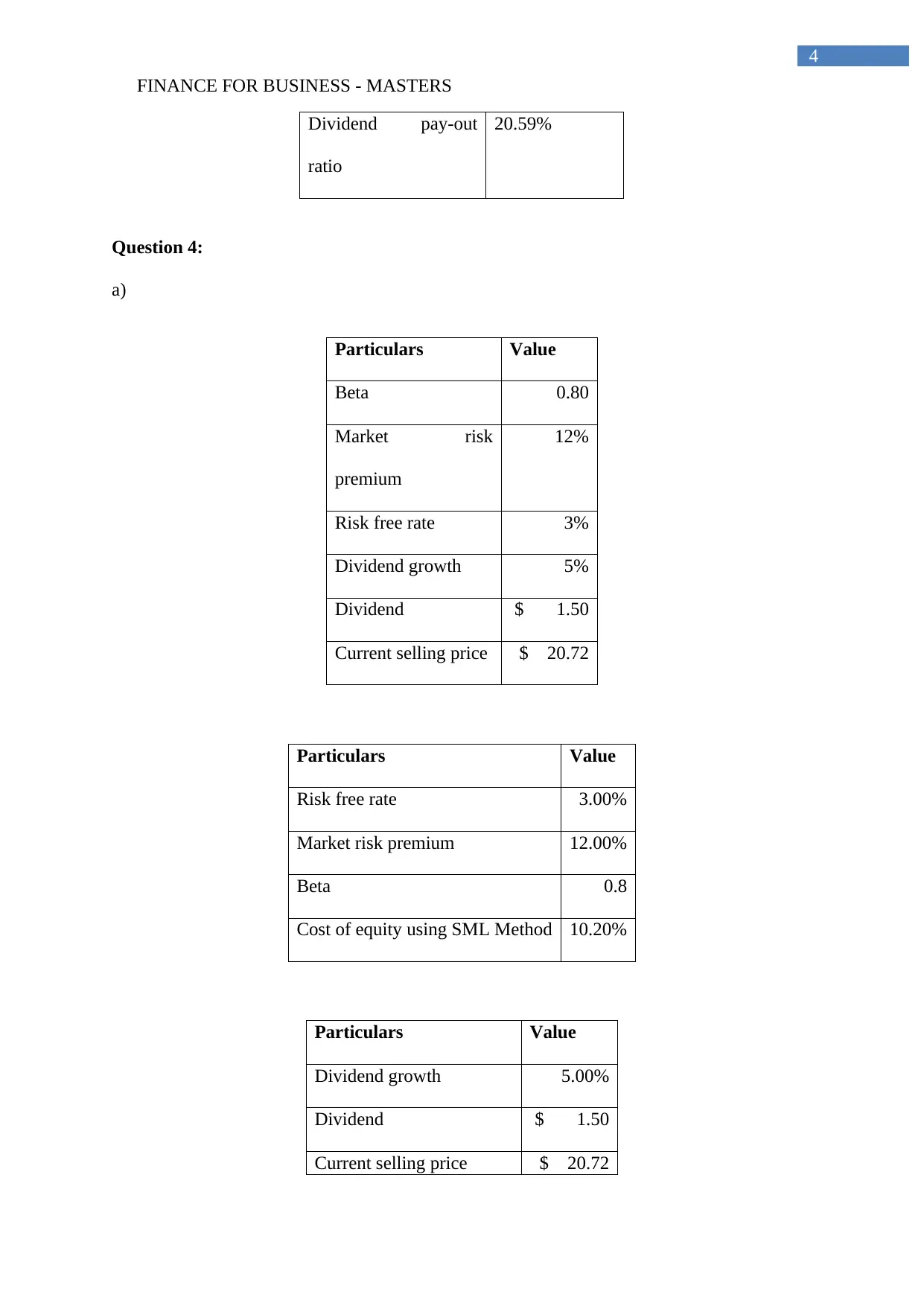
FINANCE FOR BUSINESS - MASTERS
4
Dividend pay-out
ratio
20.59%
Question 4:
a)
Particulars Value
Beta 0.80
Market risk
premium
12%
Risk free rate 3%
Dividend growth 5%
Dividend $ 1.50
Current selling price $ 20.72
Particulars Value
Risk free rate 3.00%
Market risk premium 12.00%
Beta 0.8
Cost of equity using SML Method 10.20%
Particulars Value
Dividend growth 5.00%
Dividend $ 1.50
Current selling price $ 20.72
4
Dividend pay-out
ratio
20.59%
Question 4:
a)
Particulars Value
Beta 0.80
Market risk
premium
12%
Risk free rate 3%
Dividend growth 5%
Dividend $ 1.50
Current selling price $ 20.72
Particulars Value
Risk free rate 3.00%
Market risk premium 12.00%
Beta 0.8
Cost of equity using SML Method 10.20%
Particulars Value
Dividend growth 5.00%
Dividend $ 1.50
Current selling price $ 20.72
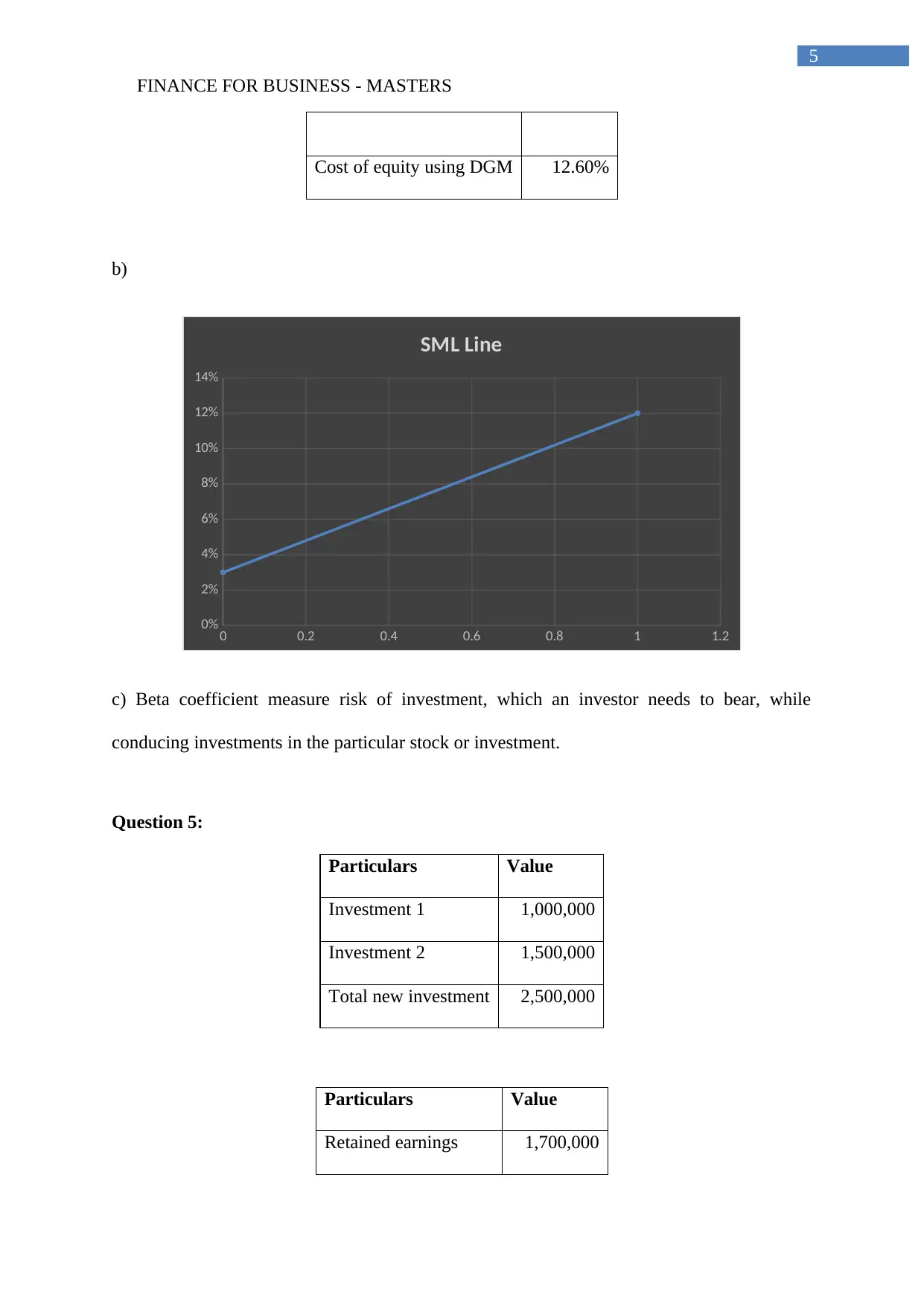
FINANCE FOR BUSINESS - MASTERS
5
Cost of equity using DGM 12.60%
b)
0 0.2 0.4 0.6 0.8 1 1.2
0%
2%
4%
6%
8%
10%
12%
14%
SML Line
c) Beta coefficient measure risk of investment, which an investor needs to bear, while
conducing investments in the particular stock or investment.
Question 5:
Particulars Value
Investment 1 1,000,000
Investment 2 1,500,000
Total new investment 2,500,000
Particulars Value
Retained earnings 1,700,000
5
Cost of equity using DGM 12.60%
b)
0 0.2 0.4 0.6 0.8 1 1.2
0%
2%
4%
6%
8%
10%
12%
14%
SML Line
c) Beta coefficient measure risk of investment, which an investor needs to bear, while
conducing investments in the particular stock or investment.
Question 5:
Particulars Value
Investment 1 1,000,000
Investment 2 1,500,000
Total new investment 2,500,000
Particulars Value
Retained earnings 1,700,000
⊘ This is a preview!⊘
Do you want full access?
Subscribe today to unlock all pages.

Trusted by 1+ million students worldwide

FINANCE FOR BUSINESS - MASTERS
6
Equity needed @40% 1,000,000
Dividend 700,000
Dividend pay-out ratio 41.18%
Question 6:
a)
Year Cash Inflows Net Income
0 $ (80,000) $ (80,000)
1 $ 25,000 $ 3,000 $ (55,000)
2 $ 25,000 $ 2,500 $ (30,000)
3 $ 25,000 $ 2,250 $ (5,000)
4 $ 25,000 $ 2,600 $ 20,000
5 $ 25,000 $ 3,200 $ 45,000
NPV $19,817.75
Payback period 3.
2
years
Profitability index 1.2
5
AAR 0.2
0
b) Under the recoup measure the company should accept the project, as the NPV is positive,
while the profitability index is higher than 1 and payback period is greater than the recoup
measurement of 4 years.
6
Equity needed @40% 1,000,000
Dividend 700,000
Dividend pay-out ratio 41.18%
Question 6:
a)
Year Cash Inflows Net Income
0 $ (80,000) $ (80,000)
1 $ 25,000 $ 3,000 $ (55,000)
2 $ 25,000 $ 2,500 $ (30,000)
3 $ 25,000 $ 2,250 $ (5,000)
4 $ 25,000 $ 2,600 $ 20,000
5 $ 25,000 $ 3,200 $ 45,000
NPV $19,817.75
Payback period 3.
2
years
Profitability index 1.2
5
AAR 0.2
0
b) Under the recoup measure the company should accept the project, as the NPV is positive,
while the profitability index is higher than 1 and payback period is greater than the recoup
measurement of 4 years.
Paraphrase This Document
Need a fresh take? Get an instant paraphrase of this document with our AI Paraphraser
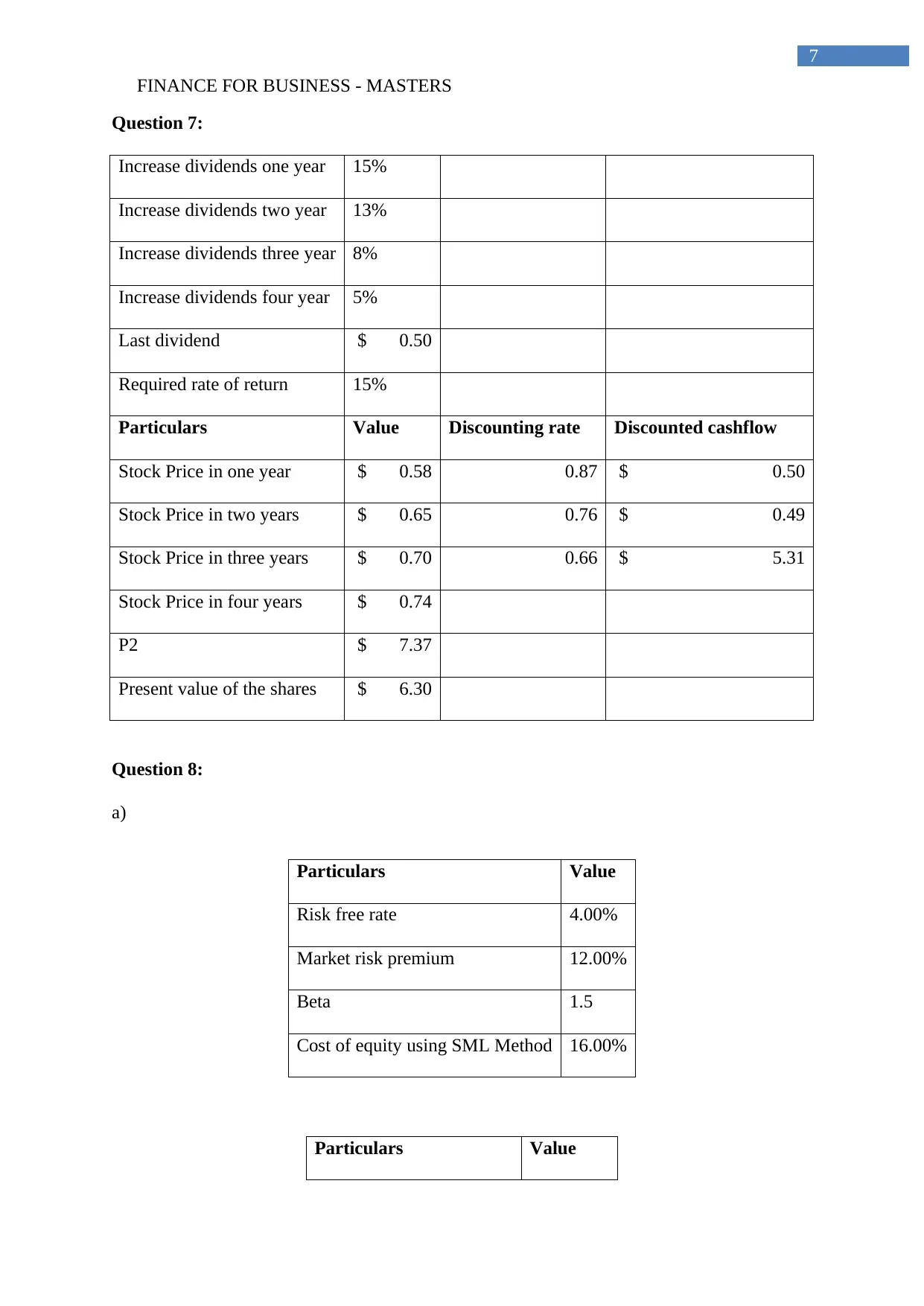
FINANCE FOR BUSINESS - MASTERS
7
Question 7:
Increase dividends one year 15%
Increase dividends two year 13%
Increase dividends three year 8%
Increase dividends four year 5%
Last dividend $ 0.50
Required rate of return 15%
Particulars Value Discounting rate Discounted cashflow
Stock Price in one year $ 0.58 0.87 $ 0.50
Stock Price in two years $ 0.65 0.76 $ 0.49
Stock Price in three years $ 0.70 0.66 $ 5.31
Stock Price in four years $ 0.74
P2 $ 7.37
Present value of the shares $ 6.30
Question 8:
a)
Particulars Value
Risk free rate 4.00%
Market risk premium 12.00%
Beta 1.5
Cost of equity using SML Method 16.00%
Particulars Value
7
Question 7:
Increase dividends one year 15%
Increase dividends two year 13%
Increase dividends three year 8%
Increase dividends four year 5%
Last dividend $ 0.50
Required rate of return 15%
Particulars Value Discounting rate Discounted cashflow
Stock Price in one year $ 0.58 0.87 $ 0.50
Stock Price in two years $ 0.65 0.76 $ 0.49
Stock Price in three years $ 0.70 0.66 $ 5.31
Stock Price in four years $ 0.74
P2 $ 7.37
Present value of the shares $ 6.30
Question 8:
a)
Particulars Value
Risk free rate 4.00%
Market risk premium 12.00%
Beta 1.5
Cost of equity using SML Method 16.00%
Particulars Value
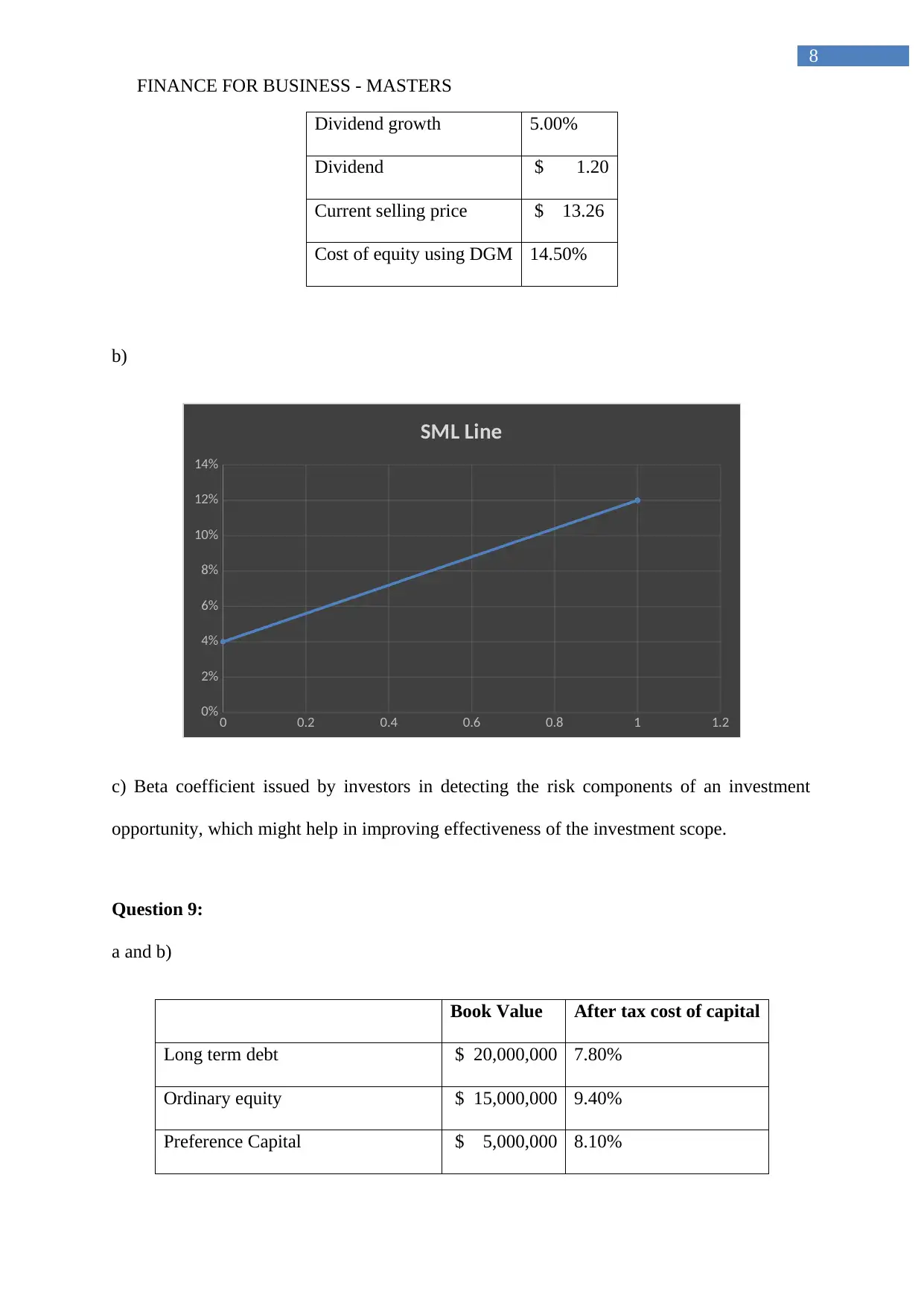
FINANCE FOR BUSINESS - MASTERS
8
Dividend growth 5.00%
Dividend $ 1.20
Current selling price $ 13.26
Cost of equity using DGM 14.50%
b)
0 0.2 0.4 0.6 0.8 1 1.2
0%
2%
4%
6%
8%
10%
12%
14%
SML Line
c) Beta coefficient issued by investors in detecting the risk components of an investment
opportunity, which might help in improving effectiveness of the investment scope.
Question 9:
a and b)
Book Value After tax cost of capital
Long term debt $ 20,000,000 7.80%
Ordinary equity $ 15,000,000 9.40%
Preference Capital $ 5,000,000 8.10%
8
Dividend growth 5.00%
Dividend $ 1.20
Current selling price $ 13.26
Cost of equity using DGM 14.50%
b)
0 0.2 0.4 0.6 0.8 1 1.2
0%
2%
4%
6%
8%
10%
12%
14%
SML Line
c) Beta coefficient issued by investors in detecting the risk components of an investment
opportunity, which might help in improving effectiveness of the investment scope.
Question 9:
a and b)
Book Value After tax cost of capital
Long term debt $ 20,000,000 7.80%
Ordinary equity $ 15,000,000 9.40%
Preference Capital $ 5,000,000 8.10%
⊘ This is a preview!⊘
Do you want full access?
Subscribe today to unlock all pages.

Trusted by 1+ million students worldwide
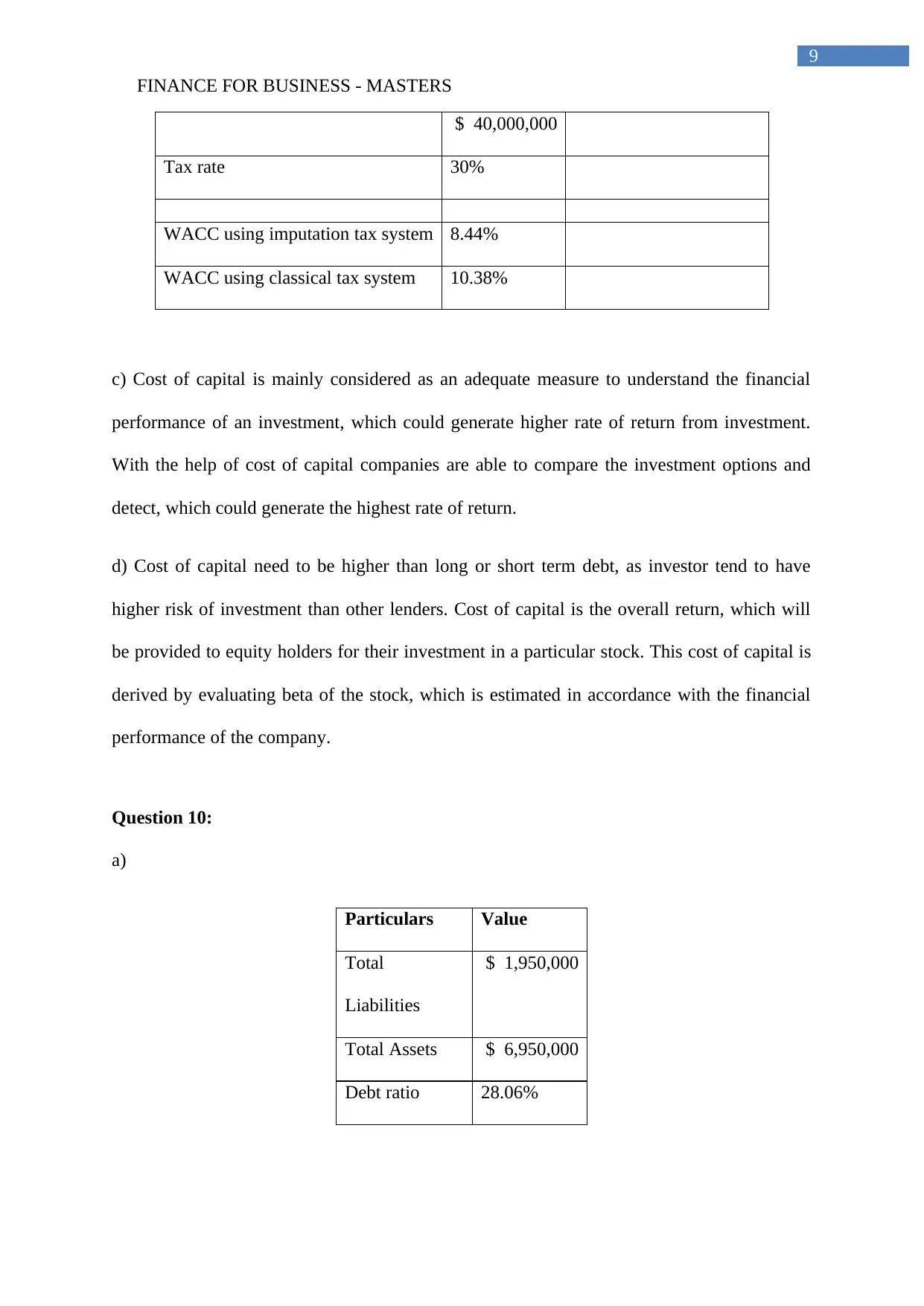
FINANCE FOR BUSINESS - MASTERS
9
$ 40,000,000
Tax rate 30%
WACC using imputation tax system 8.44%
WACC using classical tax system 10.38%
c) Cost of capital is mainly considered as an adequate measure to understand the financial
performance of an investment, which could generate higher rate of return from investment.
With the help of cost of capital companies are able to compare the investment options and
detect, which could generate the highest rate of return.
d) Cost of capital need to be higher than long or short term debt, as investor tend to have
higher risk of investment than other lenders. Cost of capital is the overall return, which will
be provided to equity holders for their investment in a particular stock. This cost of capital is
derived by evaluating beta of the stock, which is estimated in accordance with the financial
performance of the company.
Question 10:
a)
Particulars Value
Total
Liabilities
$ 1,950,000
Total Assets $ 6,950,000
Debt ratio 28.06%
9
$ 40,000,000
Tax rate 30%
WACC using imputation tax system 8.44%
WACC using classical tax system 10.38%
c) Cost of capital is mainly considered as an adequate measure to understand the financial
performance of an investment, which could generate higher rate of return from investment.
With the help of cost of capital companies are able to compare the investment options and
detect, which could generate the highest rate of return.
d) Cost of capital need to be higher than long or short term debt, as investor tend to have
higher risk of investment than other lenders. Cost of capital is the overall return, which will
be provided to equity holders for their investment in a particular stock. This cost of capital is
derived by evaluating beta of the stock, which is estimated in accordance with the financial
performance of the company.
Question 10:
a)
Particulars Value
Total
Liabilities
$ 1,950,000
Total Assets $ 6,950,000
Debt ratio 28.06%
Paraphrase This Document
Need a fresh take? Get an instant paraphrase of this document with our AI Paraphraser
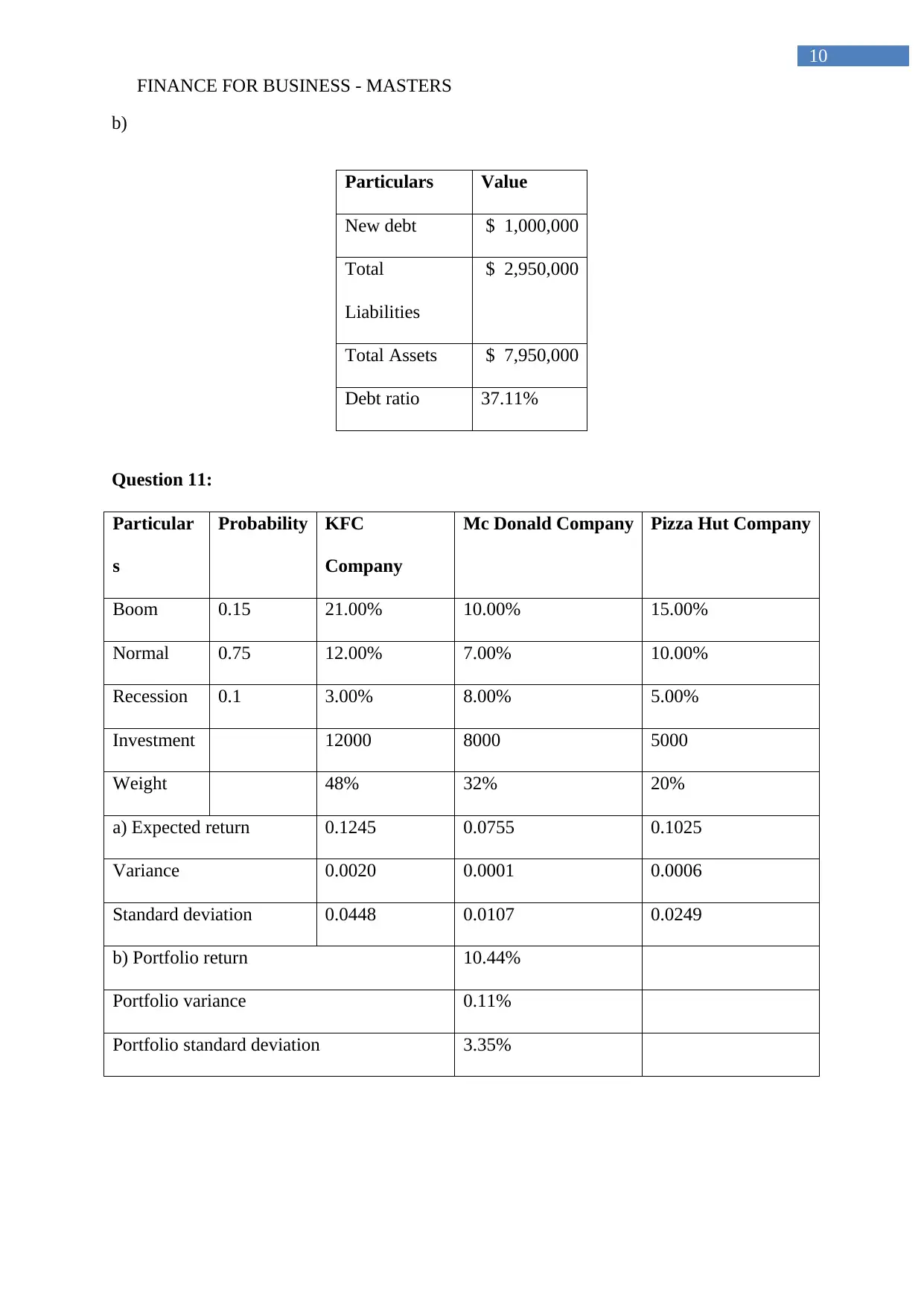
FINANCE FOR BUSINESS - MASTERS
10
b)
Particulars Value
New debt $ 1,000,000
Total
Liabilities
$ 2,950,000
Total Assets $ 7,950,000
Debt ratio 37.11%
Question 11:
Particular
s
Probability KFC
Company
Mc Donald Company Pizza Hut Company
Boom 0.15 21.00% 10.00% 15.00%
Normal 0.75 12.00% 7.00% 10.00%
Recession 0.1 3.00% 8.00% 5.00%
Investment 12000 8000 5000
Weight 48% 32% 20%
a) Expected return 0.1245 0.0755 0.1025
Variance 0.0020 0.0001 0.0006
Standard deviation 0.0448 0.0107 0.0249
b) Portfolio return 10.44%
Portfolio variance 0.11%
Portfolio standard deviation 3.35%
10
b)
Particulars Value
New debt $ 1,000,000
Total
Liabilities
$ 2,950,000
Total Assets $ 7,950,000
Debt ratio 37.11%
Question 11:
Particular
s
Probability KFC
Company
Mc Donald Company Pizza Hut Company
Boom 0.15 21.00% 10.00% 15.00%
Normal 0.75 12.00% 7.00% 10.00%
Recession 0.1 3.00% 8.00% 5.00%
Investment 12000 8000 5000
Weight 48% 32% 20%
a) Expected return 0.1245 0.0755 0.1025
Variance 0.0020 0.0001 0.0006
Standard deviation 0.0448 0.0107 0.0249
b) Portfolio return 10.44%
Portfolio variance 0.11%
Portfolio standard deviation 3.35%
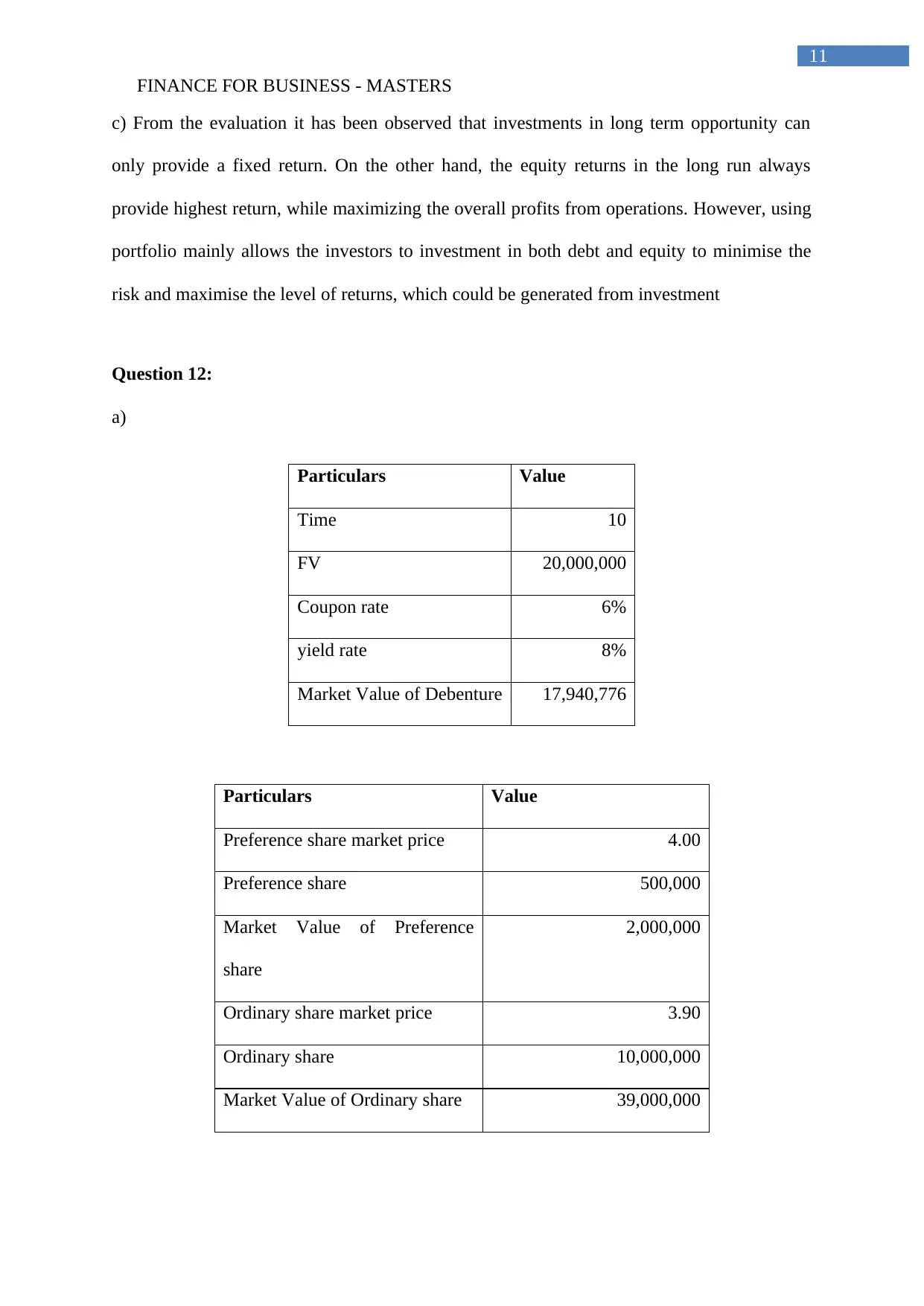
FINANCE FOR BUSINESS - MASTERS
11
c) From the evaluation it has been observed that investments in long term opportunity can
only provide a fixed return. On the other hand, the equity returns in the long run always
provide highest return, while maximizing the overall profits from operations. However, using
portfolio mainly allows the investors to investment in both debt and equity to minimise the
risk and maximise the level of returns, which could be generated from investment
Question 12:
a)
Particulars Value
Time 10
FV 20,000,000
Coupon rate 6%
yield rate 8%
Market Value of Debenture 17,940,776
Particulars Value
Preference share market price 4.00
Preference share 500,000
Market Value of Preference
share
2,000,000
Ordinary share market price 3.90
Ordinary share 10,000,000
Market Value of Ordinary share 39,000,000
11
c) From the evaluation it has been observed that investments in long term opportunity can
only provide a fixed return. On the other hand, the equity returns in the long run always
provide highest return, while maximizing the overall profits from operations. However, using
portfolio mainly allows the investors to investment in both debt and equity to minimise the
risk and maximise the level of returns, which could be generated from investment
Question 12:
a)
Particulars Value
Time 10
FV 20,000,000
Coupon rate 6%
yield rate 8%
Market Value of Debenture 17,940,776
Particulars Value
Preference share market price 4.00
Preference share 500,000
Market Value of Preference
share
2,000,000
Ordinary share market price 3.90
Ordinary share 10,000,000
Market Value of Ordinary share 39,000,000
⊘ This is a preview!⊘
Do you want full access?
Subscribe today to unlock all pages.

Trusted by 1+ million students worldwide
1 out of 19